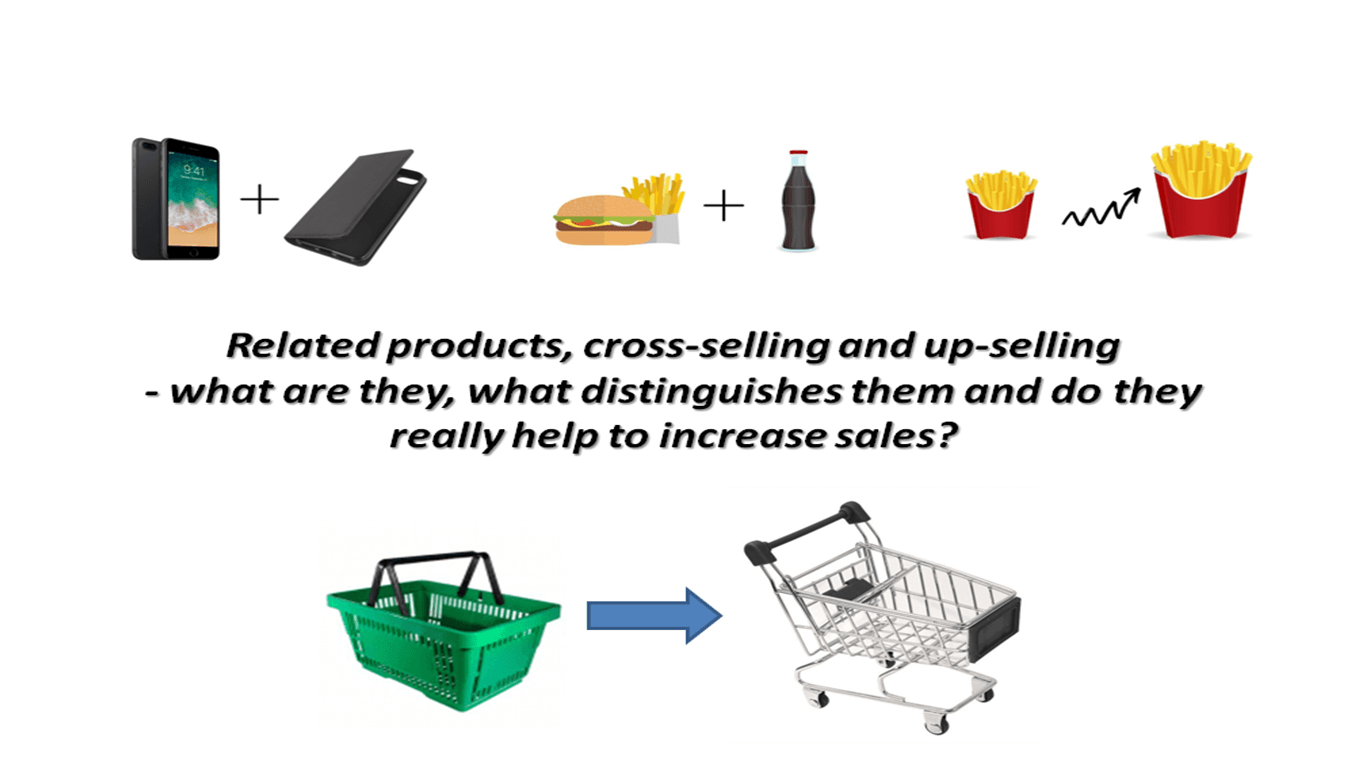Related products, cross-selling and up-selling - what are they, what distinguishes them and do they really help to increase sales?

source: own elaboration
The COVID-19 coronavirus pandemic has shown the real potential for online sales. It allows consumers to buy more conveniently, faster and more profitably - they can compare the offers of many stores at the same time, and do shopping without leaving home. From groceries to paid video materials - you can buy practically anything on the Internet today, and online stores want to sell even more, regardless of what they offer. Hence the techniques they use, such as cross-selling, up-selling or related products. What are they, what distinguishes them and does using them really help increase sales?
Related products and cross-selling
Although cross-selling is often equated with related products, these terms don’t mean the same thing. Related products are other goods or services that are spare parts for the basic product, are intended to help in its use, improve its operation or extend its scope, supplement the main product, increase satisfaction while using it, allow for its personalization, eliminate defects, etc. An example may be the purchase of accessories such as a case or tempered glass when you buy a specific phone model. As the name suggests, these are goods related to the product that the customer has or wants to purchased.
On the other hand, the selling technique called cross-selling, consists in persuading the customer to buy another, additional product or service that customer didn’t intend to buy when he entered the website of a given online store. An example may be persuasion to buy an additional blouse when choosing pants and the tool that is most often used for it is a discount. So cross-selling may or may not apply to related products. The seller can also try to persuade the customer to buy other products, not related to the goods, which are already in the basket. So, selling related products is cross-selling, but not all cross-selling techniques requires using related products.
Up-selling
Another technique to increase sales is up-selling. The idea is to persuade the customer to buy a more expensive product instead of the one originally selected or a package of additional services that will increase the purchase amount. The best-known example is proposing an additional warranty (extended or more extensive) for household appliances.
What are the advantages of using sales-enhancing techniques such as related products, cross-selling and up-selling?
All of the above-mentioned techniques for expanding sales obviously increase the value of shopping carts and thus increase the value of individual orders, but that’s not all. The seller also gains time - for example, by sending several items in one shipment or by servicing one customer instead of several. These practices also allow you to improve statistics such as the conversion rate or Customer Lifetime Value - LTV (customer value over a longer period of time).
In addition, up-selling, cross-selling and related products strengthen relationships with customers, including, above all, their commitment and allow you to retain customers for a longer period of time (even the one needed to make purchases). Let us add that consumers who are interested in buying more products (or carefully selected more expensive variants of goods they were originally interested in) are less likely to abandon their shopping carts. Each of these techniques is also a way to personalize customers because they allow sellers to build an individual approach to each consumer using automated algorithms. And it should be noted that customers expect just such an approach - they don’t have time to browse thousands of products in search of the right ones, they want to feel that the seller is offering them items which may actually be attractive to them. According to research conducted by SalesForce, personalized product recommendations generate an average of 7% of visits, but as much as 26% of revenues, and orders in which the recommendation was clicked have a 10% higher average value. According to Barilliance Research, they are responsible for 31% of e-commerce revenues.
How to use sales-increasing practices to make them as effective as possible?
In order for these techniques to be as effective as possible, they must be applied in a specific way. First of all, the seller should know his buyers and know what they expect from him. Offering them additional accessories and services cannot be intrusive, because in such a case the effect may be opposite to the assumed one. The consumer cannot perceive up-selling as an attempt to trick him, but as an advantageous offer that he should take advantage of. Similarly, in the case of cross-selling and related items - the customer must feel that the offer is attractive to him. Also, remember that you cannot overwhelm the user with hundreds of suggestions, because they may get discouraged and leave your site. So, show only the options that are most beneficial for a specific customer. For example, by recommending an additional product at a price higher than that offered by the competition - you can offend him. If it is possible, appreciate that he is shopping at your website and offer him a discount when increasing the value of the order. When programming a tool for up-selling, cross-selling or proposing related products, you should use your knowledge about customers - when creating recommendations, use their browsing history, purchase history or, if you have access to them, they preferences. The way and moment in which you try to increase the value of the order is also important - you can do it before or after making a purchase in the form of a pop-up, information shown in the basket, etc. You need to adapt the tool to your website and your users - the better the algorithm you use to choosing the right products and the way to show them to customers, the higher the effectiveness of your sales-increasing technique will be. Of course, there is another possibility - you can use the services of specialists who will create a sales-increasing tool perfectly suited to the needs of your e-business. If you are interested - contact us - we will tell you how we can help you earn more on each order.

